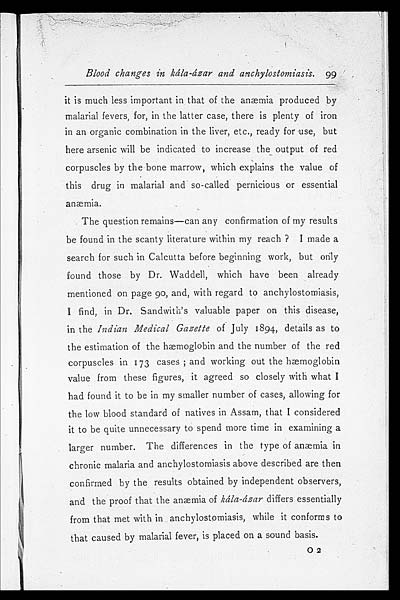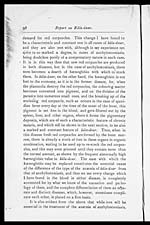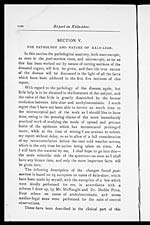Medicine - Institutions > Army health reports and medical documents > Report of an investigation of the epidemic of malarial fever in Assam, or, kala-azar > Section IV - Blood changes in kala-azar and anchylostomiasis
(124) Page 99
Download files
Individual page:
Thumbnail gallery: Grid view | List view

Blood changes in kála-ázar and anchylostomiasis.
99
it is much less important in that of the anæmia produced by
malarial fevers, for, in the latter case, there is plenty of iron
in an organic combination in the liver, etc., ready for use, but
here arsenic will be indicated to increase the output of red
corpuscles by the bone marrow, which explains the value of
this drug in malarial and so-called pernicious or essential
anæmia.
The question remains—can any confirmation of my results
be found in the scanty literature within my reach? I made a
search for such in Calcutta before beginning work, but only
found those by Dr. Waddell, which have been already
mentioned on page 90, and, with regard to anchylostomiasis,
I find, in Dr. Sandwith's valuable paper on this disease,
in the Indian Medical Gazette of July 1894, details as to
the estimation of the hæmoglobin and the number of the red
corpuscles in 173 cases; and working out the hæmoglobin
value from these figures, it agreed so closely with what I
had found it to be in my smaller number of cases, allowing for
the low blood standard of natives in Assam, that I considered
it to be quite unnecessary to spend more time in examining a
larger number. The differences in the type of anæmia in
chronic malaria and anchylostomiasis above described are then
confirmed by the results obtained by independent observers,
and the proof that the anæmia of kála-ázar differs essentially
from that met with in anchylostomiasis, while it conforms to
that caused by malarial fever, is placed on a sound basis.
O 2
Set display mode to: Large image | Zoom image | Transcription
Images and transcriptions on this page, including medium image downloads, may be used under the Creative Commons Attribution 4.0 International Licence unless otherwise stated. ![]()
| Permanent URL | https://digital.nls.uk/75014618 |
|---|




